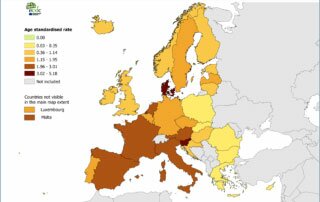This document elucidates specific problems and solutions for consumer connections in relation to legionella bacteria prevention and treatment, metering and billing options and control opportunities. Moreover, sketches that could be used as specific solutions for consumer interconnection schemes for three of the demonstration sites on public networks in the project are presented. DOWNLOAD THIS DOCUMENT >>
The report is a continuation of the report “Low temperature concepts” and is part of a set of reports that define the system architecture of the RELaTED concept.

Distribution of Legionnaries’ disease cases per 100.000 population in the EU/EEA countries, 2016. Source: Surveillance report Legionnaires’ disease.
In RELaTED Task 2.2 the design and control challenges for connections for ULT DH consumers are presented along with a discussion about the barriers regarding legionella and billing and metering of ULT DH consumption. A set of sketches of interconnections schemes for consumer installations are included.
Design and control challenges for different types of ULT DH consumer connections for space heating and DHW production respectively are presented and, when available, with possible solutions.
The barriers regarding legionella in domestic hot water installations are discussed and different studies about legionella and national requirements are presented. Some of the methods for prevention of legionella and general recommendations concerning legionella are covered.
The challenges regarding billing and metering in a ULT DH system with a combination of DH and electricity for DHW production is discussed and some methods for billing options are proposed.
The information gathered in this report will be used in the succeeding work packages of RELaTED to investigate further the architecture of the ULT concept.
A set of interconnections schemes for consumer installations in ULT DH networks are presented for different buildings types and installations. The different operation modes of a microbooster HP (Heat pump) for DHW production is explained.
The information gathered in this report will be used in the succeeding work packages of RELaTED to investigate further the architecture of the ULT concept (WP2), design and adaption of subsystems to facilitate the use of distributed energy resources (WP3), analyse the economic feasibility and business case (WP4) and prepare and conduct demonstrations (WP5), of the RELaTED project.
